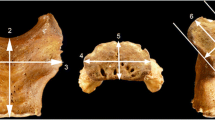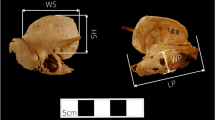Abstract
The objectives of this work were to validate two published methods for subadult age estimation based on measurements of the pars lateralis, and to develop a new method based on a wider set of measurements using the Granada Osteological Collection. The pars lateralis of 127 individuals from 6 months prenatal to 4 years of age were measured, taking 6 measurements of the body, the anterior synchondrosis and the condyle. Length and width were used to validate the published methods. Regression functions using age as the independent variable were calculated using each of the six measurements taken, and functions for age estimation were obtained through classical calibration. Functions for calculation of the 95% confidence interval of the estimates were obtained through linear regression using the estimation errors. In the validation of the previous methods, one method showed a linear tendency of the differences, which can be attributed to a circularity in reasoning in the original work. In the other method, a tendency towards overestimation was found, which can be attributed to the limitations of the method itself. The new functions have a consistency rate of 92.2% to 97.1%; the functions derived from all measurements are useful from 6 months prenatal to 2 years of age. Moreover, the functions obtained are applicable to incomplete pars lateralis, allowing for age estimation in a wide set of contexts and providing straightforward age estimates with their respective margin of error.







Similar content being viewed by others
Data availability
The dataset generated and analysed during the current study are available from the corresponding author on reasonable request.
References
AlQahtani SJ, Hector MP, Liversidge HM (2010) Brief communication: the London atlas of human tooth development and eruption. Am J Phys Anthropol 142:481–490. https://doi.org/10.1002/ajpa.21258
García-Mancuso R (2014) Congruencia entre edad esquelética y desarrollo dentario en una muestra osteológica con edad cronológica documentada. Rev Argentina Antropol Biológica 16:103–109
Irurita Olivares J, Alemán Aguilera I, Viciano Badal J, De Luca S, Botella López MC (2014) Evaluation of the maximum length of deciduous teeth for estimation of the age of infants and young children: proposal of new regression formulas. Int J Legal Med 128:345–352. https://doi.org/10.1007/s00414-013-0903-y
Cardoso HFV, Gomes J, Campanacho V, Marinho L (2013) Age estimation of immature human skeletal remains using the post-natal development of the occipital bone. Int J Legal Med 127:997–1004. https://doi.org/10.1007/s00414-013-0818-7
Irurita Olivares J, Alemán Aguilera I (2017) Proposal of new regression formulae for the estimation of age in infant skeletal remains from the metric study of the pars basilaris. Int J Legal Med 131:781–788. https://doi.org/10.1007/s00414-016-1478-1
Smith DEM, Humphrey LT, Cardoso HFV (2021) Age estimation of immature human skeletal remains from mandibular and cranial bone dimensions in the postnatal period. Forensic Sci Int 327:110943. https://doi.org/10.1016/j.forsciint.2021.110943
Cardoso HFV, Spake L, Humphrey LT (2017) Age estimation of immature human skeletal remains from the dimensions of the girdle bones in the postnatal period. Am J Phys Anthropol 163:772–783. https://doi.org/10.1002/ajpa.23248
Cardoso HFV, Vandergugten JM, Humphrey LT (2017) Age estimation of immature human skeletal remains from the metaphyseal and epiphyseal widths of the long bones in the post-natal period. Am J Phys Anthropol 162:19–35. https://doi.org/10.1002/ajpa.23081
Picó Pérez C, Irurita Olivares J, Alemán Aguilera I (2017) Validation methods of Fazekas and Kósa and Molleson and Cox for age estimation of the ilium in Western Mediterranean non-adult population: proposal of new regression formulas. Int J Legal Med 131:789–795. https://doi.org/10.1007/s00414-016-1475-4
Redfield A (1970) A new aid to aging immature skeletons: development of the occipital bone. Am J Phys Anthropol 33:207–220. https://doi.org/10.1002/ajpa.1330330206
Fazekas IG, Kósa F (1978) Forensic fetal osteology. Akadémiai Kiadó, Budapest
Scheuer L, MacLaughlin-Black S (1994) Age estimation from the pars basilaris of the fetal and juvenile occipital bone. Int J Osteoarchaeol 4:377–380. https://doi.org/10.1002/oa.1390040412
Thornton R, Edkins AL, Hutchinson EF (2020) Contributions of the pars lateralis, pars basilaris and femur to age estimations of the immature skeleton within a South African forensic setting. Int J Legal Med 134:1185–1193. https://doi.org/10.1007/s00414-019-02143-9
Scheuer L, Black S (2004) The juvenile skeleton. Academic Press, San Diego
Alemán I, Irurita J, Valencia AR, Martínez A, Lõpez-Lázaro S, Viciano J, Botella MC (2012) Brief communication: the Granada osteological collection of identified infants and young children. Am J Phys Anthropol 149:606–610. https://doi.org/10.1002/ajpa.22165
Lin LI-K (1989) A concordance correlation coefficient to evaluate reproducibility. Biometrics 45:255–268. https://doi.org/10.2307/2532051
McBride GB (2005) A proposal for strength-of-agreement criteria for Lin’s concordance correlation coefficient. Hamilton, New Zealand
R Development Core Team (2019) R: A language and environment for statistical computing. R Foundation for Statistical Computing, Vienna. https://www.R-project.org/
Aykroyd RG, Lucy D, Pollard AM, Solheim T (1997) Regression analysis in adult age estimation. Am J Phys Anthropol 104:259–265. https://doi.org/10.1002/(sici)1096-8644(199710)104:2%3C259::aid-ajpa11%3E3.0.co;2-z
Wickham H (2016) ggplot2: elegant graphics for data analysis. Springer-Verlag, New York
Lucy D (2005) Introduction to statistics for forensic scientists. Wiley, Chichester
Greenwell BM, Schubert Kabban CM (2014) investr: an R Package for inverse estimation. R J 6:90–100
Cameron N (2022) The pattern of human growth. In: Cameron N, Schell LM (eds) Human growth and development, 3rd edn. Academic Press, San Diego, pp 1–22
Stinson S (2012) Growth variation: biological and cultural factors. In: Stinson S, Bogin B, O’Rourke D (eds) Human biology: an evolutionary and biocultural perspective. Wiley, Hoboken, pp 587–635
Braga J, Treil J (2007) Estimation of pediatric skeletal age using geometric morphometrics and three-dimensional cranial size changes. Int J Legal Med 121:439–443. https://doi.org/10.1007/s00414-007-0170-x
Tangmose S, Thevissen P, Lynnerup N, Willems G, Boldsen J (2015) Age estimation in the living: transition analysis on developing third molars. Forensic Sci Int 257:512.e1-512.e7. https://doi.org/10.1016/j.forsciint.2015.07.049
Konigsberg LW, Frankenberg SR (2013) Bayes in biological anthropology. Am J Phys Anthropol 152:153–184. https://doi.org/10.1002/ajpa.22397
Ferrante L, Skrami E, Gesuita R, Cameriere R (2015) Bayesian calibration for forensic age estimation. Stat Med 34:1779–1790. https://doi.org/10.1002/sim.6448
Funding
Gonzalo Figueiro received partial financial support from the Comisión Sectorial de Investigación Científica, Universidad de la República, Uruguay (2019 Academic Mobility and Exchanges Programme).
Author information
Authors and Affiliations
Corresponding author
Ethics declarations
Ethical Approval
Not applicable.
Informed Consent
Not applicable.
Research involving Human Participants and/or Animals
Not applicable.
Conflict of interest
The authors declare no competing interests.
Additional information
Publisher's note
Springer Nature remains neutral with regard to jurisdictional claims in published maps and institutional affiliations.
Rights and permissions
About this article
Cite this article
Figueiro, G., Irurita Olivares, J. & Alemán Aguilera, I. Age estimation in infant skeletal remains by measurements of the pars lateralis. Int J Legal Med 136, 1675–1684 (2022). https://doi.org/10.1007/s00414-022-02867-1
Received:
Accepted:
Published:
Issue Date:
DOI: https://doi.org/10.1007/s00414-022-02867-1




